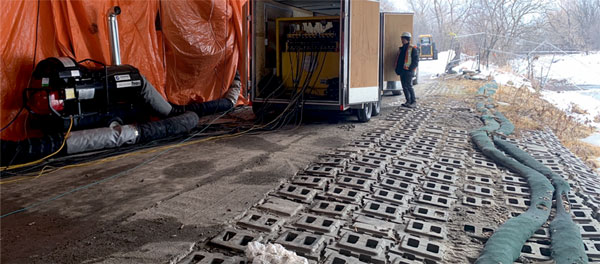A unique construction method called bridge jacking is being used to lift the Humber Bridge above a busy intersection in Toronto while cars are driving on it.
The bridge is being lifted at Islington Avenue and Finch Avenue West as part of the Finch West light rail transit (LRT) project.
“The purpose of the bridge jacking project is to refurbish, reinforce and strengthen the bridge’s foundations for works needed to accommodate the Finch West LRT’s guideway,” a Metrolinx spokesperson said in an email to the Daily Commercial News.
“Repairs and reinforcement of the bridge needed to happen, but we couldn’t afford to shut down the entire Finch and Islington intersection that sits overtop. By jacking and reinforcing each girder individually while traffic continues to flow overtop, restoration and reconstruction work can be completed both more quickly and with less disruption than other techniques.”
For the Finch West LRT, Metrolinx is the owner. The project is being delivered through a public-private partnership by Mosaic Transit Group, consisting of ACS Infrastructure Canada Inc., Aecon and CRH Canada Group Inc.
Work on this portion of the project has been ongoing since January and should take three months to complete. Once the work is finished, the bridge will be widened and upgraded.
The bridge is being lifted six millimetres.

“It is a multi-pronged process that is completed in various stages,” the spokesperson noted. “Bridge jacking is a process that ensures the structural integrity of a bridge remains unaffected as work is in progress. In the case of the Humber River Bridge, the key architectural components of its concrete girders are lifted incrementally, as teams refurbish each one.”
Teams have lifted the bridge using 18 hydraulic jacks controlled by hydro pressure and electricity from nearby control panels, states a Metrolinx blog, adding the jacks move at the same time and speed to lift hundreds of tons of concrete, steel and moving vehicles simultaneously. In total, 60 girders will be jacked up during the bridge’s refurbishment.
“When people hear that a bridge is being raised, they usually think it’s much higher, but this is more like trying to slide a piece of paper under a laptop,” Tommy Medeiros, superintendent, construction, civil and utilities, explained in the Metrolinx blog.
The type of jack being used is a pedestal jack. The pedestals are mounted on the face of the abutments and then they jack the bridge up on girders.
All bearings on the bridge, which carry the loads or movement in vertical and horizontal directions from the superstructure and transfers those loads to the bridge’s pier and abutments, will be replaced quickly using the jacking technique with new rubber pads with metal for reinforced strength and endurance.
“By working incrementally, we’re only affecting a small segment of the bridge at any given time,” the spokesperson noted. “The jacking technique is also a lot less invasive than a traditional bridge repair job, allowing us to minimize our footprint and the amount of heavy machinery required on the roadway.”
Working over a waterway did create a few challenges.
“A challenge the team faced throughout this process was getting access to the spaces where it was necessary to install heavy machinery, as they are working over a waterway and deep slopes,” stated the spokesperson. “Heavy equipment had to be carried down embankments carefully and the team had to ensure the ground could support the load of this large machinery.”
Once the machinery was in place, two large control units were set up to control the 18 jacks.
Mosaic was also required to secure clearance for working over a navigable waterway through the Navigable Waters Act from the federal government.
Erosion and sedimentary control mitigation measures were also installed to prevent sediment from entering the Humber River.
The bridge’s entire underside features secured scaffolding that is fully floored, which doubles as extra security for teams working on the scaffolding, as well as a mechanism to catch any debris.
A lot of planning went into the project including ensuring all environmental procedures are in place.
“Each section lift requires one-to-two weeks of planning,” Medeiros said. “The execution does not take all that long to perform, but planning for every conceivable contingency, including ensuring team and public safety, takes a lot of preparation.”
Follow the author on Twitter @DCN_Angela.











Recent Comments
comments for this post are closed